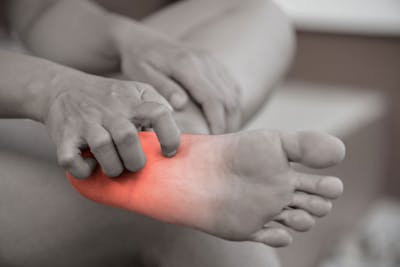
What Is Peripheral Neuropathy?
Peripheral Neuropathy (PN) is a condition that affects the nerves in the body causing pain, changes in sensation, or alterations in muscle activity. This condition is frequently a complication of diabetes, where chronic high blood sugar levels cause damage to nerves all over the body. Nearly half of all diabetics experience peripheral neuropathy, which will typically affect their lower extremities. However, in some rare cases, PN affects the arms, abdomen, and back.
What Are The Symptoms Of PN?
Damage due to Diabetic Peripheral Neuropathy can affect different types of nerves such as motor nerves (e.g. muscle movement), sensory nerves (e.g. touch), or autonomic nerves (e.g. organs). Because of this non-selective nerve damage, the symptoms are variable and widespread. People with PN may experience:
- Numbness and tingling, most commonly starting in the feet and hands, and possibly spreading up the limbs
- Loss or absence of sensation (the ability to sense contact with outside objects)
- Pain, often described as burning, sharp, or “electric-like”
- Increased sensitivity to light touch
- Weakness or paralysis in the muscles or parts of the body affected by the nerve or nerves
- Bowel or bladder changes; nerves controlling these functions may be affected
- Decreased balance or Coordination and Falls
- Poor wound healing
- Excessive sweating or skin dryness
- Flushed or pale skin
- Abnormal nail growth
- Decreased ability to participate in normal functional activities
How Is PN Diagnosed?
If you have any of the above symptoms, your physician may want to conduct a thorough examination to make a proper diagnosis based on your reflexes, muscle strength, and sensation. These diagnostic tests may include:
- Nerve conduction tests measure the speed of nerve signal conduction to detect damage to the nerve
- Electromyography measures the strength of muscular responses to their corresponding nerve signals
How Can Aquatic Therapy Help With My PN?
Our 94-degree therapy pools, through a combination of hydrostatic pressure and heat, increase overall blood flow and circulation throughout the body. This increase in oxygen flow through the patient’s neuropathic areas helps to alleviate pain and promote nourishment and repair at the affected sites. Your therapist may begin or finish your therapy session in our state-of-the-art infrared sauna to further increase blood circulation and tissue repair.
The loss of sensation and coordination associated with peripheral neuropathy may further increase the risk of falls and injury. By participating in aquatic physical therapy, our neuropathic patients can establish a balanced center more easily because of the surrounding hydrostatic pressure and natural resistance of the water. These natural properties of water also help increase the strength and endurance of muscles in a low impact setting that doesn’t aggravate existing pains.
Another benefit of performing therapy in our warm saltwater pools is an increase in sensitivity because the body is being constantly stimulated by the water. This aids in pain management, restoring sensation, and regaining strength in the affected areas. The overall process of muscle toning and nerve conditioning also serves as excellent cardiovascular exercise which can help maintain blood glucose levels that contribute to peripheral neuropathy.


